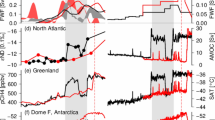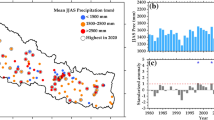Abstract
The early Holocene, about 9,500 years ago (9.5 ka BP), was still affected by the presence of remnant ice sheets and their melting. Using as a reference a simulation of the early Holocene, the present study explores the relative contribution of these two factors on the climate mean state and ENSO variability in the tropical Pacific with the IPSL coupled model. The melting water flux and remnant ice sheets both induce a North Atlantic cooling and a southward shift of the ITCZ. Atmospheric teleconnections and local coupled ocean–atmosphere feedbacks lead to a remote SST cooling in the eastern equatorial Pacific. Both forcing factors also weaken the SST annual cycle in the eastern equatorial Pacific, closely related to the zonal wind stress anomalies. Compared with the early Holocene reference run, the freshwater flux experiment exhibits enhanced ENSO amplitude. A feedback analysis suggests that it is due to the wind–thermocline feedback. The remnant ice sheet experiment does not show significant change in ENSO. It exhibits a slight SST variability increase at the east coast and a reduction in the middle of the basin driven by the net heat flux feedback. All experiments reproduce the classical Eastern Pacific (EP) El Niño, and the central Pacific El Niño. The freshwater flux forcing strengthens the amplitude of EP El Niño events due to the stronger wind–thermocline feedback in this experiment. These results suggest that ice sheet melting and the remnant ice-sheet have partially counteracted the insolation forcing in the early Holocene.











Similar content being viewed by others
References
Alexander MA, Blade I, Newman M, Lanzante JR, Lau NC, Scott JD (2002) The atmospheric bridge: the influence of ENSO teleconnections on air–sea interaction over the global oceans. J Clim 15:2205–2231
An SI, Choi J (2014) Mid-Holocene tropical Pacific climate state, annual cycle, and ENSO in PMIP2 and PMIP3. Clim Dyn 43:957–970. doi:10.1007/s00382-013-1880-z
An SI, Ham YG, Kug JS, Timmermann A, Choi J, Kang IS (2010) The inverse effect of annual-mean state and annual-cycle changes on ENSO. J Clim 23:1095–1110
Bellenger H, Guilyardi E, Leloup J, Lengaigne M, Vialard J (2014) ENSO representation in climate models: from CMIP3 to CMIP5. Clim Dyn 42:1999–2018
Bellucci A, Gualdi S, Navarra A (2010) The double-ITCZ syndrome in coupled general circulation models: the role of large-scale vertical circulation regimes. J Clim 23(5):1127–1145
Berger AL (1978) Long-term variations of daily insolation and quaternary climatic changes. J Atmos Sci 35(12):2362–2367
Boer G, Flato G, Reader MC, Ramsden D (2000) A transient climate change simulation with greenhouse gas and aerosol forcing: experimental design and comparison with the instrumental record for the twentieth century. Clim Dyn 16(6):405–425
Braconnot P, Otto-Bliesner B, Harrison S, Joussaume S, Peterchmitt JY, Abe-Ouchi A, Crucifix M, Driesschaert E, Fichefet T, Hewitt CD, Kageyama M, Kitoh A, Laine A, Loutre MF, Marti O, Merkel U, Ramstein G, Valdes P, Weber SL, Yu Y, Zhao Y (2007) Results of PMIP2 coupled simulations of the Mid-Holocene and last glacial maximum-Part1: experiments and large-scale features. Clim Past 3(2):261–277. doi:10.5194/cp-3-261-2007
Braconnot P, Luan Y, Brewer S, Zheng W (2012) Impact of Earth’s orbit and freshwater fluxes on Holocene climate mean seasonal cycle and ENSO characteristics. Clim Dyn 38(5–6):1081–1092. doi:10.1007/s00382-011-1029-x
Broccoli A, Dahl K, Stouffer R (2006) Response of the ITCZ to Northern Hemisphere cooling. Geophys Res Lett 33:L01702. doi:10.1029/2005GL024546
Carlson AE, Legrande AN, Oppo DW, Came RE, Schmidt GA, Anslow FS, Licciardi JM, Obbink EA (2008) Rapid early Holocene deglaciation of the Laurentide ice sheet. Nat Geosci 1(9):620–624. doi:10.1038/ngeo285
Carré M et al (2014) Holocene history of ENSO variance and asymmetry in the eastern tropical Pacific. Science 345:1045–1048
Clarke GKC, Leverington DW, Teller JT, Dyke AS (2004) Paleohydraulics of the last outburst flood from Glacial Lake Agassiz and the 8200 BP cold event. Quat Sci Rev 23(3–4):389–407. doi:10.1016/j.quascirev.2003.06.004
Cobb KM, Westphal N, Sayani HR, Watson JT, Lorenzo ED, Cheng H, Edwards RL, Charles CD (2013) Highly variable El Niño-Southern Oscillation throughout the Holocene. Science 339(6115):67–70
Dahl KA, Broccoli AJ, Stouffer RJ (2005) Assessing the role of North Atlantic freshwater forcing in millennial scale climate variability: a tropical Atlantic perspective. Clim Dyn 24:325–346
Delworth T, Manabe S, Stouffer R (1993) Interdecadal variations of the thermohaline circulation in a coupled ocean–atmosphere model. J Clim 6:1900–1989
Dong B, Sutton R (2007) Enhancement of ENSO variability by a weakened Atlantic thermohaline circulation in a coupled GCM. J Clim 20:4920–4939. doi:10.1175/JCLI4284.1
Dong B, Sutton R, Scaife AA (2006) Multidecadal modulation of El Niño-Southern Oscillation (ENSO) variance by Atlantic Ocean sea surface temperatures. Geophys Res Lett 33:L08705. doi:10.1029/2006GL025766
Gu D, Philander SGH (1995) Secular changes of annual and interannual variability in the tropics during the past century. J Clim 8:864–876
Guilyardi E (2006) El Niño–mean state–seasonal cycle interactions in a multi-model ensemble. Clim Dyn 26:329–348
Guilyardi E, Braconnot P, Jin FF, Kim ST, Kolasinski M, Li T, Musat I (2009) Atmosphere feedbacks during ENSO in a coupled GCM with a modified atmospheric convection scheme. J Clim 22(21):5698–5718
Jin F, Kim ST, Bejarano L (2006) A coupled stability index for ENSO. Geophys Res Lett 33:L23708. doi:10.1029/2006GL027221
Kao HY, Yu JY (2009) Contrasting Eastern-Pacific and Central-Pacific types of ENSO. J Clim 22:615–632
Kug JS, Jin FF, An SI (2009) Two types of El Niño events: cold tongue El Niño and warm pool El Niño. J Clim 22(6):1499–1515. doi:10.1175/2008JCLI2624.1
Latif M, Kleeman R, Eckert C (1997) Greenhouse warming, decadal variability, or El Niño? An attempt to understand the anomalous 1990s. J Clim 10:2221–2239
Lau NC (1997) Interactions between global SST anomalies and the midlatitude atmospheric circulations. Bull Am Meteor Soc 78:21–33
Leloup J, Lengaigne M, Boulanger JP (2008) Twentieth century ENSO characteristics in the IPCC database. Clim Dyn 30:277–291
Li T (1997) Air–sea interactions of relevance to the ITCZ: analysis of coupled instabilities and experiments in a hybrid coupled GCM. J Atmos Sci 54:134–147
Lloyd J, Guilyardi E, Weller H, Slingo J (2009) The role of atmosphere feedbacks during ENSO in the CMIP3 models. Atmos Sci Lett 10(3):170–176
Luan Y, Braconnot P, Yu Y, Zheng W, Marti O (2012) Early and mid-Holocene climate in the tropical Pacific: seasonal cycle and interannual variability induced by insolation changes. Clim Past 8:1093–1108. doi:10.5194/cp-8-1093-2012
Manabe S, Stouffer RJ (1988) Two stable equilibria of thermohaline circulation. J Clim 1:841–866
Marti O, Braconnot P, Dufresne JL, Bellier J, Benshila R, Bony S, Brockmann P, Cadule P, Caubel A, Codron F, de Noblet N, Denvil S, Fairhead L, Fichefet T, Foujols MA, Friedlingstein P, Goosse H, Grandpeix JY, Guilyardi E, Hourdin F, Idelkadi A, Kageyama M, Krinner G, Levy C, Madec G, Mignot J, Musat I, Swingedouw D, Talandier C (2010) Key features of the IPSL ocean atmosphere model and its sensitivity to atmospheric resolution. Clim Dyn 34(1):1–26. doi:10.1007/s00382-009-0640-6
Marzin C, Braconnot P (2009) Variations of Indian and African monsoons induced by insolation changes at 6 and 95 kyr BP. Clim Dyn 33(2–3):215–231
Marzin C, Braconnot P, Kagayama M (2013) Relative impacts of insolation changes, meltwater fluxes and ice sheets on African and Asian monsoons during the Holocene. Clim Dyn 41(9–10):2267–2286
McPhaden MJ, Zebiak SE, Glantz MH (2006) ENSO as an integrating concept in Earth science. Science 314(5806):1740–1745
Merkel U, Prange M, Schulz M (2010) ENSO variability and teleconnections during glacial climates. Quat Sci Rev 29(1–2):86–100. doi:10.1016/j.quascirev.2009.11.006
Moy CM, Seltzer GO, Rodbell DT, Anderson DM (2002) Variability of El Niño/Southern Oscillation activity at millennial timescales during the Holocene epoch. Nature 420(6912):162–165
Otto-Bliesner BL, Brady EC, Shin SI, Liu Z, Shields C (2003) Modeling El Niño and its tropical teleconnections during the last glacial-interglacial cycle. Geophys Res Lett 30(23):2198. doi:10.1029/2003GL018553
Peltier WR (2004) Global glacial isostasy and the surface of the ice-age earth: the ice-5G (VM2) model and grace. Annu Rev Earth Planet Sci 32:111–149
Press WH, Teukolsky SA, Vetterling WT, Flannery BP (1992) Numerical recipes. Cambridge University Press, Cambridge
Ressen H, Seppa H, Heiri O, Roche DM, Goosse H, Fichefet T (2009) The spatial and temporal complexity of the Holocene thermal maximum. Nat Geosci 2(6):410–413
Swingedouw D, Braconnot P, Marti O (2006) Sensitivity of the Atlantic meridional overturning circulation to the melting from northern glaciers in climate change experiments. Geophys Res Lett 33(7):L07, 711
Swingedouw D, Mignot J, Braconnot P, Mosquet E, Kageyama M, Alkama R (2009) Impact of freshwater release in the North Atlantic under different climate conditions in an OAGCM. J Clim 22(23):6377–6403
Timmermann A, Oberhuber J, Bacher A, Latif M, Roeckner E (1999) Increased El Niño frequency in a climate model forced by future greenhouse warming. Nature 398:694–696
Timmermann A, An S, Krebs U, Goosse H (2005) ENSO suppression due to a weakening of the North Atlantic thermohaline circulation. J Clim 18:3122–3139
Timmermann A, Okumura Y, An SI, Clement A, Dong B, Guilyardi E, Hu A, Jungclaus JH, Renold M, Stocker TF, Stouffer RJ, Sutton R, Xie SP, Yin J (2007) The influence of a weakening of the Atlantic meridional overturning circulation on ENSO. J Clim 20:4899–4919
Trenberth KE, Branstator GW, Karoly D, Kumar A, Lau NC, Ropelewshi C (1998) Progress during TOGA in understanding and modeling global teleconnections associated with tropical sea surface temperatures. J Geophys Res 103:14291–14324
Vellinga M, Wood RA (2002) Global climatic impacts of a collapse of the Atlantic thermohaline circulation. Clim Change 54:251–267
Vellinga M, Wood R, Gregory JM (2002) Processes governing the recovery of a perturbed thermohaline circulation in HadCM3. J Clim 15:764–779
Xiang B, Wang B, Ding Q, Jin FF, Fu X, Kim HJ (2012) Reduction of the thermocline feedback associated with mean SST bias in ENSO simulation. Clim Dyn 39(6):1413–1430. doi:10.1007/s00382-011-1164-4
Xie SP, Philander SGH (1994) A coupled ocean–atmosphere model of relevance to the ITCZ in the eastern Pacific. Tellus 46A:340–350
Xie SP, Okumura Y, Miyama T, Timmermann A (2008) Influences of Atlantic climate change on the tropical Pacific via the Central American Isthmus. J Clim 21(15):3914–3928. doi:10.1175/2008JCLI2231.1
Yeh SW, Kug JS, Dewitte B, Kwon MH, Kirtman BP, Jin FF (2009) El Niño in a changing climate. Nature 461:511–514. doi:10.1038/nature08316
Yu JY, Kim ST (2010) Identification of Central-Pacific and Eastern-Pacific types of ENSO in CMIP3 models. Geophys Res Lett 37(15):L15705. doi:10.1029/2010GL044082
Yu Y, Sun DZ (2009) Response of ENSO and the mean state of the tropical Pacific to extratropical cooling and warming: a study using the IAP coupled model. J Clim 22(22):5902–5917
Zhang R, Delworth T (2005) Simulated tropical response to a substantial weakening of the Atlantic thermohaline circulation. J Clim 18:1853–1860
Zheng W, Braconnot P, Guilyardi E, Merkel U, Yu Y (2008) ENSO at 6 ka and 21 ka from ocean–atmosphere coupled model simulations. Clim Dyn 30:745–762
Acknowledgments
The NEC SX8 computing time requested to run the simulations has been provided by CEA (France). This study contributes to the French ANR Project ELPASO (No. 2010 BLANC 608 01). This study was jointly supported by the Chinese National Basic Research Program (Grant Nos. 2012CB955202 and 2010CB950502) and the National Natural Science Foundation of China (Grant No. 41376002).
Author information
Authors and Affiliations
Corresponding author
Rights and permissions
About this article
Cite this article
Luan, Y., Braconnot, P., Yu, Y. et al. Tropical Pacific mean state and ENSO changes: sensitivity to freshwater flux and remnant ice sheets at 9.5 ka BP. Clim Dyn 44, 661–678 (2015). https://doi.org/10.1007/s00382-015-2467-7
Received:
Accepted:
Published:
Issue Date:
DOI: https://doi.org/10.1007/s00382-015-2467-7




